BigTime Watch Kit
It's official, SparkFun has made the Big Time, and now you can make it too! The BigTime watch kit is a geekishly stylish digital watch with a velcro watch-band and a slick acrylic enclosure. If it seems familiar, that's because it's essentially our open-source branch from the SpikenzieLabs' Solder:Time kit. The heart of the kit is the much venerated ATMega328 using a 32kHz clock-source to keep time. To check the time, just press the button on the side of the watch and it pops up on a 4-digit 7-segment LED display. Thanks to some low-level hackery, the ATMega is running at super low power and should get an estimated 2 years of run time on a single CR2032 coin cell!
The BigTime is a through-hole kit with a low parts-count, so it makes a great project for beginning solderers. After you've finished soldering together the PCB, simply stack the acrylic pieces around it and screw them together with the included hex-head screws. Once that's done, pop in the coin-cell battery and go show off your nerd bling!
Did we mention that the watch kit is super hackable? An FTDI header is broken out to the side of the board and the watch-firmware is running on top of a bootloader! This means that all you need to do to add your own code is to open up Arduino or Wiring and select "Arduino Pro or Pro Mini 3.3V/8MHz w/ ATmega328" as your board.
We've updated the BigTime Kit to make it easier to put together! Some PCB changes will make it easy to solder, the changes we've made to the enclosure make it easier to assemble and we've also updated the Kit Guide!
Replaces:KIT-10870
- 1 x Pre-programmed ATMega328 DIP IC
- 1 x 4-Digit 7-Segment Display
- 1 x 32kHz Crystal
- 1 x 10kOhm Resistor
- 2 x 0.1uF Capacitors
- 1 x Right Angle Tactile Button
- 1 x 20mm Coin Cell Battery Holder
- 1 x 20mm Coin Cell Battery
- 4 x 4-40 Screws
- 1 x Velcro Watch Band
- Acrylic Enclosure Parts
Assembly Guide
A soldering iron and wire cutters are the bare minimum tools required. We scoured the earth and found a really fantastic beginner's soldering iron for $10, solder for $2, and wire cutters for $2. We also have a Learn to Solder version of the kit which includes all the tools you'll need!
- Very hackable ATMega328-based kit with Arduino bootloader
- All through-hole components
- Estimated 2-year battery life
- Laser-cut acrylic enclosure
- Large, easy-to-read display
- Adjustable velcro watch-band
- Schematic
- Eagle Files
- Github (latest firmware, enclosure files, etc.)
- Adventures in Low Power Land
Comments
Looking for answers to technical questions?
We welcome your comments and suggestions below. However, if you are looking for solutions to technical questions please see our Technical Assistance page.
Customer Reviews
No reviews yet.

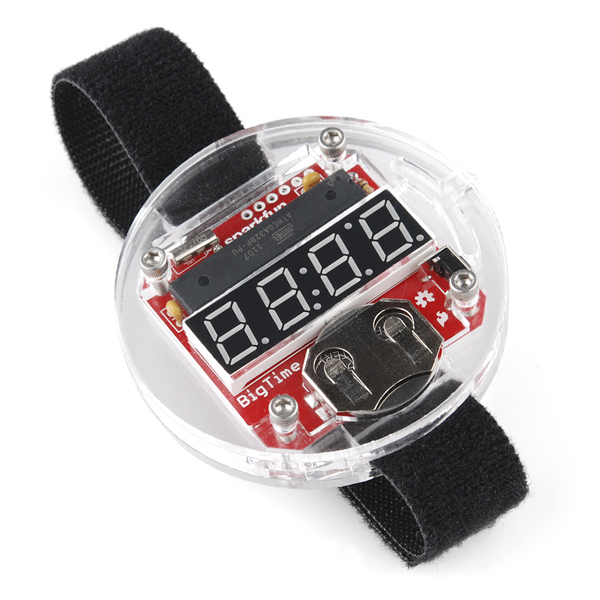
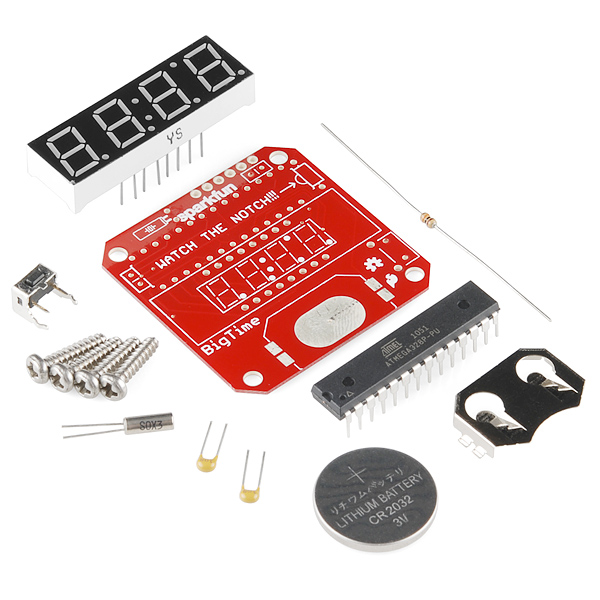
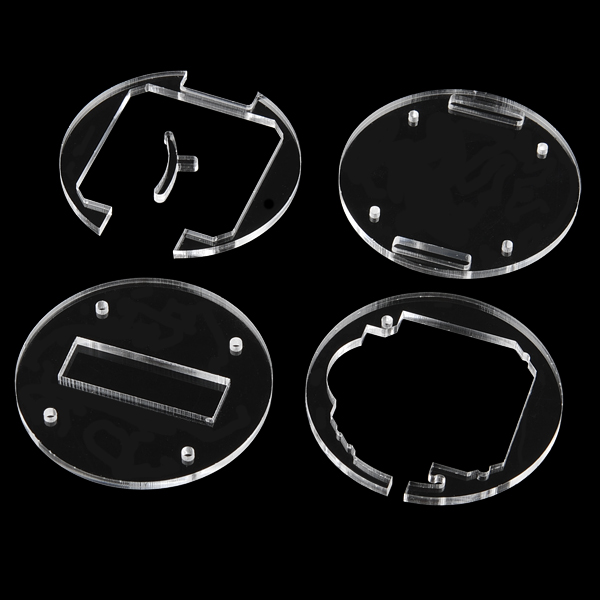
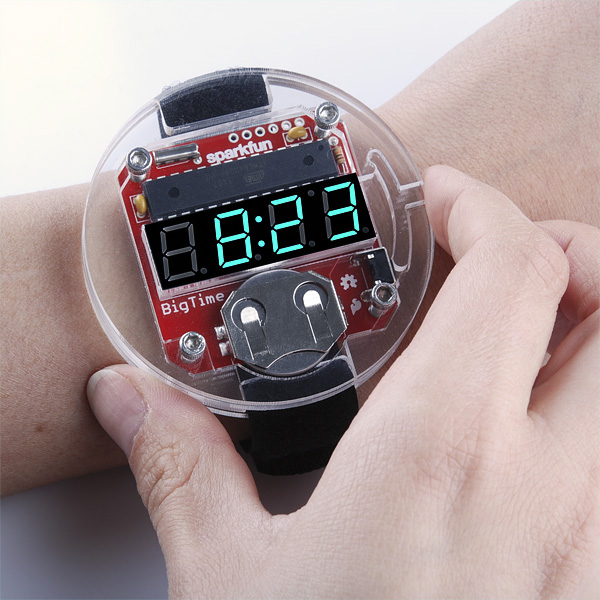
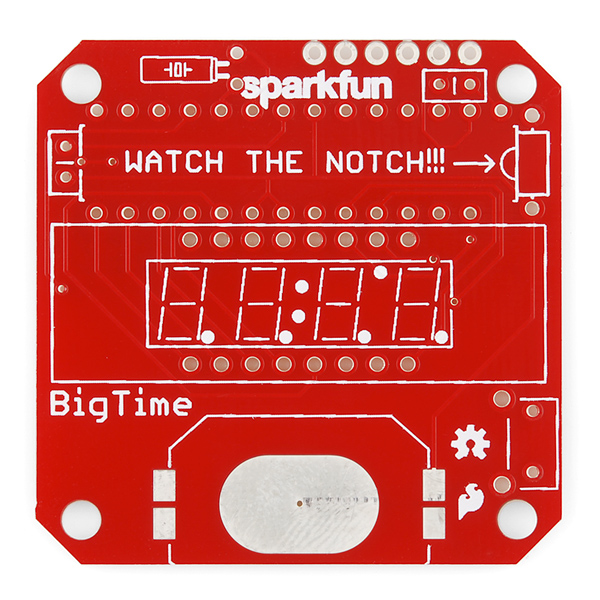
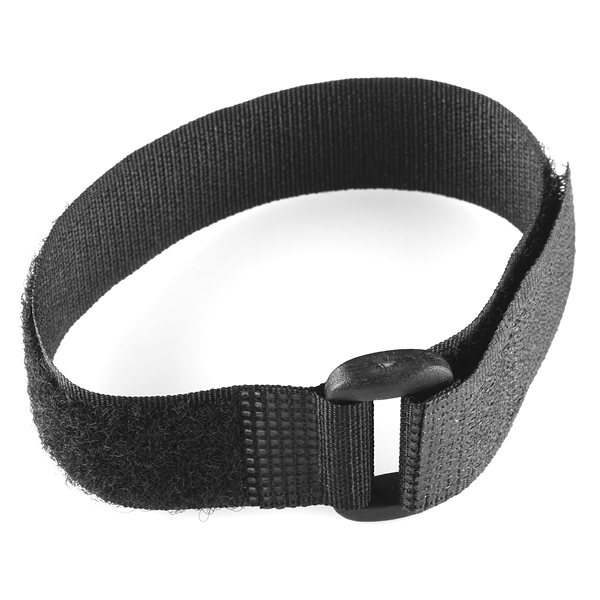
I had trouble with the watch constantly resetting itself and the time while wearing it, so I eventually had to jumper across R1, the 100k resistor. If/when I interface it with a programmer I'll have to remove it - temporarily!
No doubt this was due to the accumulation of static on the case itself causing the reset line to "flap", and static electricity can be a real problem in the winter here in the low humidity of the western U.S. - particularly if you are wearing anything synthetic!
There still is a problem with the unit randomly lighting up and displaying the time, this also being due to static. Apparently some of the lines driving the display are held in a Hi-Z state and they can be dragged around, too, and causing the the same effect as pushing the button.
I suppose that the choices are to put a resistor on the line to drag it to the appropriate state when the display is dark (current would only be increased slightly while the display is lit) or, possibly reprogramming it to keep those pins in the "output" mode which may make it less static-sensitive. It may be that I also need to add a resistor to the button line (pin 4) to bolster the internal pull-up, but bench-testing indicated that these other lines were definitely static-sensitive!
When assembling the case I coated each acrylic piece with "Nu-Finish" car polish. Long having used this to treat other plastic pieces (CDs and their jewel cases, other plastic parts) it goes a long way in preventing scratches as its polymer bonds to the surface pretty well and decreases its coefficient of friction considerably. Doing this may contribute to the static problem, but acrylic is pretty good about that on its own, anyway!
Finally, as far as accuracy goes: Mine seems to be fast by about 30-45 seconds per month. I suppose that I could tweak the 32kHz oscillator a bit, but I've not really bothered. Being open-source, it would be pretty easy to add a "calibrate" mode to occasionally add/subtract a second to help compensate for the portion of drift that isn't temperature-related.
I'm a little confused about adding headers for the FTDI. I'm thinking all you need are 6 pins worth from a breakaway header. Is that right? If you just solder them in, would the case still be able to screw together or would you have to remove them after reprograming to close it all back up?
To answer my own question, the pins have to be removed to close the case back up.
What we'll do quite a bit around here is stick a 6-pin length of M-M header into the FTDI socket, and stick the other end of the header into the holes on the Big Time board. Then if you lightly wedge everything at an angle, you'll get a solid connection while you're reprogramming the board.
Does it read 12-hour or 24-hour time by default?
check the code //Set the 12hourMode to false for military/world time. Set it to true for American 12 hour time. int TwelveHourMode = true;
so by default it's 12 hours.
Thanks.
Is the clock accurate? How many minutes or hours :) it lose per months? I want to make an alarm clock with a special twist...
Just got 2 of these, but the packages include 16 MHz crystal instead of a 32 kHz crystal! More people with this problem?!
I have the same issue. How can I solve it? Do I need to get the 32Khz one? -.-
The kit is designed to work with the 32kHz crystal. If you got a kit with the wrong crystal in it, email us at techsupport at sparkfun dot com and include your order number. We'll get you the right one sent out.
same here... my watch only displays the time that I set...
Hi! I have arduino uno, can i upload the code using arduino to a ATMEGA328p chip??
thank you! marC:)
The easiest way to program the chip is to use an FTDI board like this one: https://www.sparkfun.com/products/9873. The ATMEGA328p already has a bootloader on it.